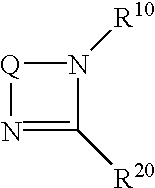Coupling catalyst and process using the same
a technology of coupling catalyst and catalyst, which is applied in the direction of physical/chemical process catalyst, metal/metal-oxide/metal-hydroxide catalyst, organic compound/hydride/coordination complex catalyst, etc., can solve the problems of limited reaction activity of the catalyst containing triethylamine, unsatisfactory reactions using 2,2′-bipyridyl or triethylamine, etc., and achieve good selectivity
- Summary
- Abstract
- Description
- Claims
- Application Information
AI Technical Summary
Benefits of technology
Problems solved by technology
Method used
Image
Examples
example 1
[0167]Under argon atmosphere, 0.4 mmol (61 mg) of p-methoxyphenylboronic acid, 0.3 mmol (5 mg) of 3-chlorotoluene, 1.13 mmol (240 mg) of potassium phosphate, 0.030 mmol (4.6 mg) of 1,8-diazabicyclo[5.4.0]-7-undecene and 0.015 mmol (4.1 mg) of bis(1,5-cyclooctadiene)nickel were added to 1 ml of dioxane in a reaction vessel. The resulting reaction solution was warmed to a temperature of 80° C., and was stirred for 3 hours at the same temperature. After completion of the reaction, the reaction mixture was left standing at room temperature, 10 ml of 1N hydrochloric acid were added thereto to dissolve potassium phosphate. The resulting mixture was transferred to a separatory funnel, extracted with ethyl acetate, and the separated organic phase was washed with saturated aqueous sodium chloride solution. The obtained desired product of the reaction, 4-methoxy-3′-methylbiphenyl showed 99% peak area, and a byproduct, 3,3′-dimethylbiphenyl showed 1% peak area in the chromatogram. Conversion o...
example 2 to 12
[0168]In Examples 2 to 11, 0.030 mmol of the nitrogen-containing cyclic compounds shown in Table 1 were used respectively in place of 1,8-diazabicyclo[5.4.0]-7-undecene used in Example 1 and the reactions were conducted in a similar manner as in Example 1.
[0169]In Examples 7 and 11, the figures shown in the parenthesis are the result obtained by using 0.5 ml of tetrahydrofuran in place of dioxane and the reactions were conducted for 8 hours in place of 3 hours in Example 1.
[0170]In Example 10, the figures shown in the parenthesis are the results obtained by using 1 ml of ethyleneglycol dimethy ether was used in place of dioxane and the reaction temperature was set at 100° C. in place of 80° C. and the reaction was continued for 8 hours in place of 3 hours in Example 1.
[0171]In Examples 8 and 9, 0.060 mmol of the nitrogen-containing cyclic compounds listed in Table 1 were used.
example 13
[0179]The reaction was conducted in a similar manner as in Example 1 except that 0.4 mmol (60 mg) of 2,5-dimethylphenylboronic acid was used in place of p-methoxyphenylboronic acid and 0.030 mmol (2.5 mg) of N-methylimidazole was used in place of 1,8-diazabicyclo[5.4.0]-7-undecene. The gaschromatography analysis of the reaction mixture showed that 3-methyl-2′,5′-dimethylbiphenyl: 99%, byproduct 3,3′-dimethylbiphenyl: 0%, and unreacted 3-chlorotoluene: 1%.
PUM
| Property | Measurement | Unit |
|---|---|---|
| pKa | aaaaa | aaaaa |
| pKa | aaaaa | aaaaa |
| pKa | aaaaa | aaaaa |
Abstract
Description
Claims
Application Information
 Login to View More
Login to View More - R&D
- Intellectual Property
- Life Sciences
- Materials
- Tech Scout
- Unparalleled Data Quality
- Higher Quality Content
- 60% Fewer Hallucinations
Browse by: Latest US Patents, China's latest patents, Technical Efficacy Thesaurus, Application Domain, Technology Topic, Popular Technical Reports.
© 2025 PatSnap. All rights reserved.Legal|Privacy policy|Modern Slavery Act Transparency Statement|Sitemap|About US| Contact US: help@patsnap.com



